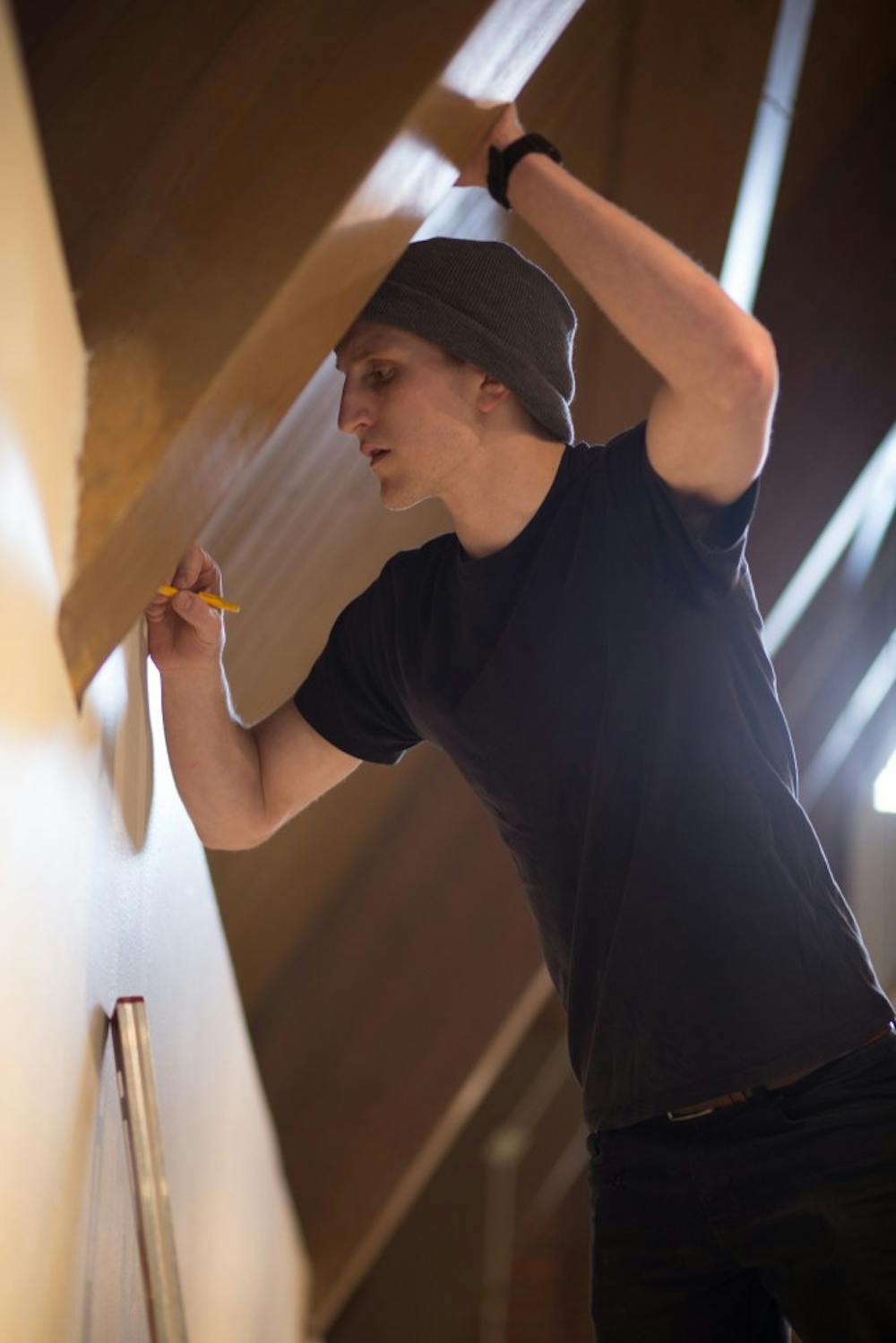Taking on the system
Students in the graphic design capstone course use their artistic vision to advocate for social justice in prisons

Rockford senior Austin Scogg marks the wall to hang a portrait for the design capstone "The System" in the University Art Gallery on March 29.
The gloomy weather matched the ambiance inside the dreary concrete building — Isabella County Jail — where Austin Scogg was visiting with his class last semester.
With no windows to the outside, Scogg felt trapped. He’d only been in the jail for a few hours, but the visit felt like an eternity.
Scogg is a student in the Graphic Design Capstone Experience course. The class of 18 toured the jail in the fall to find an experience that would make them understand what inmates in the Isabella County Jail go through each day.
“The jail in Mount Pleasant was shocking (because) we actually got to see the inmates,” Scogg said. “It kind of took me by surprise — it almost seemed like a zoo. (There) was just a bunch of people locked up and no one really talked to them besides other inmates.
“It didn’t seem like we were in Mount Pleasant. (It felt) like we were in a whole different world.”
Students taking the graphic design capstone course usually work on individual projects to showcase at the end of the year, said David Stairs, graphic design professor. This year, the class chose to go in a different direction and worked collaboratively to create an exhibit together.
The result was a project called “In the System.”
The exhibit centers on humanitarian issues in the U.S. criminal justice system. Through their art, students aimed to offer a realistic portrayal of an inmate’s experiences and bring awareness to injustices in the corrections department.
“In the System” will be on display in the University Art Gallery until April 15, during normal Art Gallery business hours — 11 a.m. to 6 p.m., Monday through Friday and 11 a.m. to 3 p.m. on Saturdays. A celebratory reception will be on Saturday, April 8 from 2-4 p.m.
The capstone class spent three semesters researching, designing and creating the project. Stairs said they were motivated to making something that mattered.
“(In the System is) something that touched lives and informed people, and showed people a different way (of) looking at a serious and relevant contemporary topic, Stairs said.
This group is very congenial and collegial, and (were) willing to lose their identity in this project and dedicate themselves to the greater good.”
USING ART TO ADVOCATE JUSTICE
Bethany Kinz was one of several students in the capstone course who hesitated when Stairs suggested a project about prisons, jails and criminal justice.
The New Lothrop senior thought it wouldn’t be received well. She also thought the class would struggle to create diverse content. However, as students began researching prison systems, her opinion quickly changed.
“After you start to research, you realize how corrupt it is,” Kinz said. “It is so important for people, especially in America (with) all the issues going on right now, to understand what our government is doing and how the prison system runs.”
The class watched documentaries, read news articles and found statistics to educate themselves on prisons and jails.
To find and capture the feeling they wanted to elicit at their exhibition, they visited the Isabella County Jail and Cell Block 7, a prison museum in Jackson. Students also wrote letters to prisoners across the country. The students said they received powerful messages in return.
Those who were hesitant at first said they were blind to the realities of the criminal justice system until they began their research. Later, they became motivated to enlighten the public with their findings. From there, Kinz said she and other students started planning how to use their diverse talents to tell a story.
Interacting with inmates both in jail and prison helped students develop empathy for them. It was a powerful and emotional motivator for the graphic designers. Scogg said he became completely invested in the project when his class finally visited the local jail. That’s when the reality of inmates’ mistreatment sunk in, he said.
“I started to grow a feeling (of) empathy toward the prisoners and (became driven toward) getting the information out there for other people,” Scogg said.
Receiving letters from prisoners made an impact on students. All the prisoners involved expressed gratitude toward the class for letting their voices be heard.
One prisoner, a poet, left an especially lasting impression on students. In his letter, the man described his perspective from a life in prison.
“I am not just a number, I am not just property, I am not going to be quiet and let the world forget that I am here,” the prisoner wrote. “I have eyes to see injustice, tongue to taste violence.”
Kinz said the poet’s letter made her heart sink.
“You remember that they’re not just inmates and they’re not just a number,” Kinz said. “You almost feel for them because they are dads and brothers or moms. They become civilians again, they become people. They’re not just inmates after you read that.”
COLLABORATING TALENTS AND ART FORMS
The students each designed a variety of pieces for the exhibit that reflect a specific struggle or feeling revealed by their research and interactions.
“We strove to find ways to present the information that would inform people,” Stairs said.
They strove to create a unique experience that branded the prison system by utilizing the inmate experience to give viewers an idea of what that experience is like, Stairs continued.
When guests enter the University Art Gallery to see the exhibit, they are required to sign in or register with their thumb print, as if they are actually being booked in jail.
Attendees are then instructed to walk a certain way when they stroll through the gallery, with their movements controlled to represent the prisoner’s restraints.
By using paintings, projected animations, structures and live performances, the exhibit demonstrates the harsh reality of solitary confinement, reform, racial imbalances and incarceration rates.
Algonac senior Austin Wirgau designed templates for the prisoner portraits in the expedition. In the portraits, he incorporated enlarged images of their letters.
The class incorporated the letters into the portraits because they wanted to create a way visitors could connect strongly with the inmates portrayed in the art.
“We wanted a way to get their words out, rather than our interpretation of it,” Wirgau said. “That was one thing we were afraid of because it’s easy for a class of privileged college students to say all this stuff, but it’s cool that they can actually directly talk to the viewer.”
SEEING INMATES AS HUMAN
Throughout the course, students stopped viewing prisoners as statistics and started seeing them as people.
“I don’t think they should be locked out of the whole world, shut off and forgot about,” Scogg said. “There needs to be some kind of procedure, or reform, to help the ones like drug addicts.”
Mount Pleasant senior Ian Etinenne said it’s tragic how these people are defined by the worst moment of their lives. The course made him realize prisoners are more than the crimes they commit.
“It makes you think about the people who are in there every day,” Etinenne said. “We don’t think about them when we’re just living our daily lives on the outside, but there is someone who is facing a life (of being) restricted and punished.”
Marion senior Joshua Keeler stressed that the class not only wants to influence public opinion about the system, but spark a continued conversation about finding reform that works to better conditions in the criminal justice system.
“We were trying to bring awareness and encourage conversation,” Keeler said. “If we do that, we’ve done our job.”




